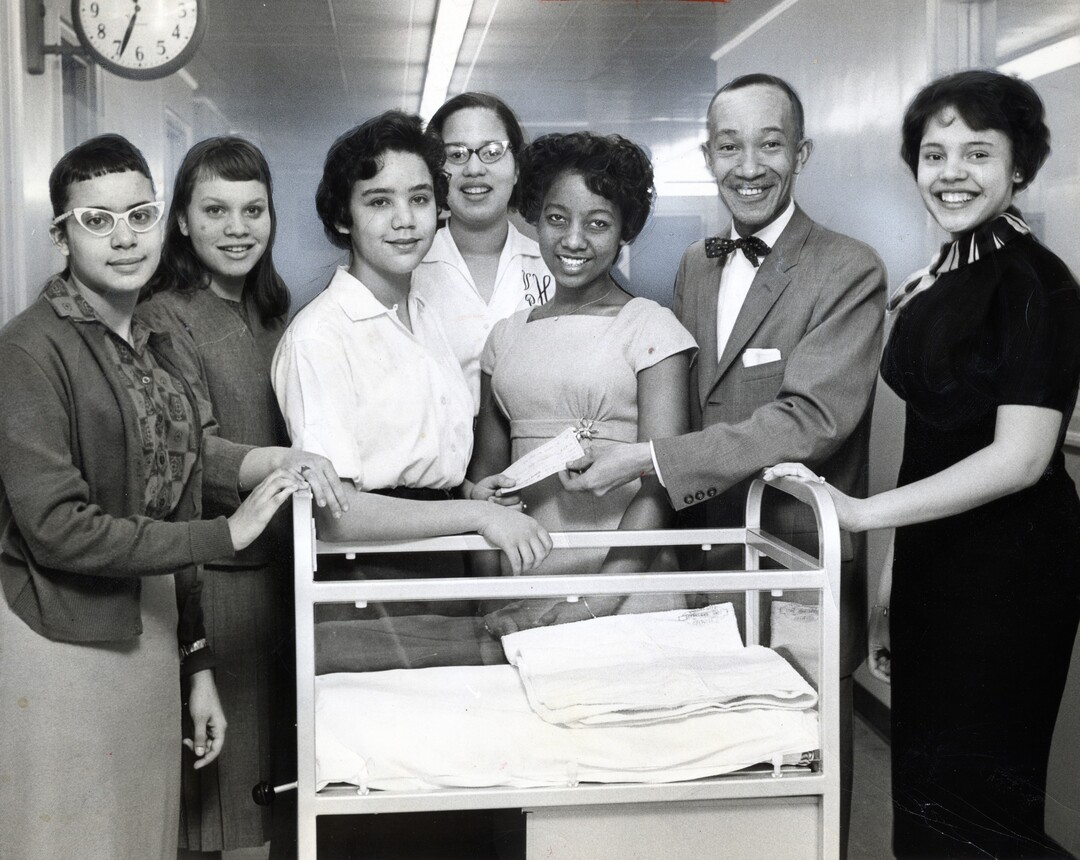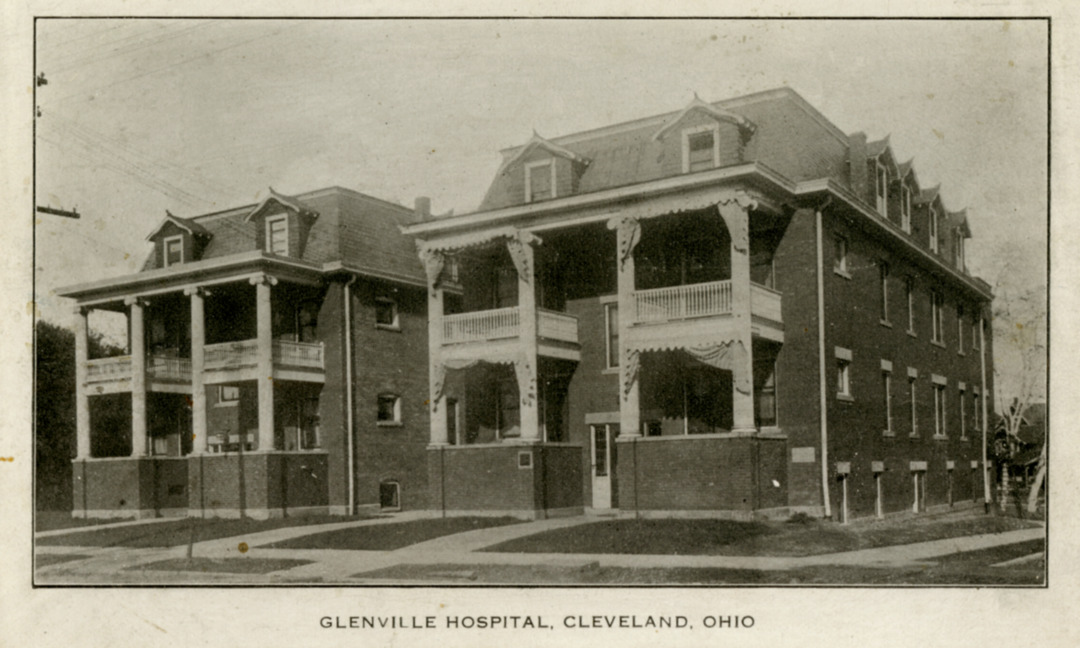
Forest City Hospital, located in the Glenville neighborhood, was considered Cleveland’s first fully interracial hospital when it opened in 1957. The site of the hospital was on the grounds of the old Glenville Hospital at 701 Parkwood Avenue, which was eventually entirely razed for the development of Forest City. This construction was made possible by the Forest City Hospital Association, which was formed in 1939 by physicians and community members who supported the creation of an interracial hospital that could effectively serve Cleveland's Black population and provide an institution where Black physicians could find steady work. Some of the prominent founding members of the Forest City Hospital Association included Dr. Ulysses Grant Mason Jr., Dr. Middleton H. Lambright, and Dr. Samuel Freedlander.
Throughout the decades preceding the opening of Forest City Hospital, there had been active discussion among Cleveland’s medical community and public advocacy from local civic organizations for the development of such a facility. In 1930, about 35 Black physicians practiced in Cleveland, with only five being employed securely as staff of the Western Reserve Society Medical School. The rest were forced to seek positions at institutions where they might be subjected to outright discrimination through unequal working conditions and unjust terminations. Many African American physicians reported that though they were forced to work long hours, it was not an uncommon occurrence not to work directly with a single patient over an entire shift as white patients would request to see a white doctor while Black patients were routinely denied care by institutions for a variety of reasons. Along with physicians who pushed for the creation of a hospital where they would be accepted fully and find solid work, the ever-growing Black population of Cleveland also exerted pressure on the established hospital systems. Between 1910 and 1940, Cleveland's African American population grew from 8,488 to nearly 85,000. This increase in population, and subsequently patients seeking medical care, elicited unsatisfactory responses from Cleveland hospitals. Some institutions established specific days that served as the only times when Black patients were even considered to receive care, while some institutions enacted policies whereby Black patients were forced to wait and receive care in the oldest wings of a building and be treated only using the oldest equipment.
These major problems in the treatment of Black physicians and the care available to the entire Cleveland Black community led to the establishment of the Forest City Hospital Association in 1939. Of the 39 founding members, nine were Black physicians hoping to spark the creation of a new institution free from racial discrimination and bias. The association searched for properties where they could either build a brand-new building or renovate an existing one. Eventually, the organization decided that the site of the old Glenville Hospital would be suitable as it was in a prime location to serve the Black community in Cleveland’s east side neighborhoods. Throughout the 1940s and into the 1950s, the Forest City Hospital Association worked closely with the Cleveland branch of the NAACP, which they viewed as the likeliest source of significant funding for the construction of a new interracial hospital. However, this proposed cooperation in the building of a medical facility would be fraught with dilemmas due to disagreements on exactly where and how such a project would be undertaken. Specifically, the NAACP was continually reluctant to commit any large sum of money towards the building of a new hospital as they had already recently invested in building two other hospitals to serve black communities in New York and Chicago, each of which had proved to be a financial drag on the NAACP. In May 1954, the NAACP voted to formally disapprove of plans presented by the Forest City Hospital Association to tear down the old Glenville Hospital and create a new building. This vote effectively ended the NAACP’s involvement in the initial funding of the new facility. Opportunely, the Forest City Hospital Association had gained favor in the public eye and forged connections with other Cleveland organizations willing to help fund the project. In 1954, the Cleveland Hospital Fund granted $404,000 to the Forest City Hospital Association, allowing it to break ground at the old Glenville Hospital site. In 1955, with construction just underway, Ohio Governor Frank J. Lausche launched a public subscription campaign in support of the hospital. This effort, along with other fundraising activities conducted by the Forest City Hospital Association, contributed an additional $641,000 to the total fund.
After just over two years of construction, Forest City Hospital officially opened its doors to patients on August 4, 1957, with Cleveland's Call & Post newspaper declaring the institution to be "A hospital for all." The hospital initially held 92 beds, but it would eventually become a 103-bed facility. Among the care offerings at Forest City Hospital were general practice and family care, surgery, gynecology, emergency services, and state-of-the-art X-ray and imaging services. In just its first year of operation, Forest City Hospital admitted over 2,500 patients, conducted over 1,300 surgical operations, took over 4,500 X-rays, and was the site of over 500 births. Of 53 physicians on staff, 26 were Black, as were most of the other hospital staff such as nurses and technicians. For its entire time in operation, Forest City Hospital served as an institution where anyone, regardless of race, could receive high-quality and timely medical care without risk of discrimination or segregation.
Forest City Hospital functioned comfortably for nearly a decade until 1967, when concerns over the building’s ability to add more beds and facilities to accommodate an ever-growing population came to a head. For the next several years, the hospital embarked on a new fundraising campaign in an attempt to raise enough money to build a new expansion and effectively double the total amount of bed space. However, throughout the early 1970s total admissions fell and consistently occupied bed space declined, jeopardizing the plans for any new expansion. From the loss of this potential fundraising and the inability to renovate, the quality of services at Forest City Hospital reportedly fell. Moving forward, Forest City Hospital began to prioritize outpatient and supportive services, along with keeping a high-quality emergency care unit running. By the 1970s, nearly all medical organizations in Cleveland had removed major barriers targeting Black patients and healthcare workers from finding care and work. Coupled with the facilities of Forest City becoming outdated and with no hope of a renovation for the hospital, patients and physicians continually left for other Cleveland institutions. Beset by financial stress, low admissions, and a shortage of physicians and nurses, Forest City Hospital finally closed in 1978. Although it lasted barely over two decades, Forest City Hospital provided a crucial lifeline in an era of struggle for access to quality healthcare.
Images



